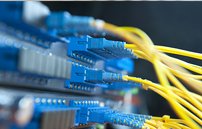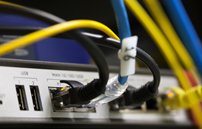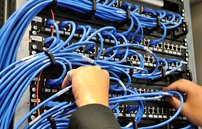
Network cabling installation is a key component of contemporary commercial operations. It enables seamless communication, efficient data transfer, and collaboration between employees and other stakeholders. Businesses rely on network infrastructure to facilitate internet connectivity, support critical applications, and enable resource sharing.
Network cabling installation enhances productivity and improves security measures, safeguarding valuable data and ensuring regulatory compliance. Network cabling installation is essential for businesses looking to maximise technology to ensure innovation and competitiveness.
At MSE, our qualified and experienced technicians provide a comprehensive network cabling installation and maintenance service. From fiber optic cable installation to facilitating effective CCTV installation, MSE can ensure your data cable installation meets your requirements.
A long-term investment
Cabling is perhaps the most significant component of your network. Once installed it has a long life span of between 15 to 20 years. During this time it’s likely you’ll need to replace your network equipment three to four times. Because cabling is such an important and long-lasting investment you should expect your cabling to be around 15% of your total network cost. It’s important to invest in the highest-quality cabling system that you can afford to guarantee reduced downtime and maintenance. The higher the quality of the cable, the better the network performance.
Types of cabling
What type of cable does MSE install?
At MSE we install the two principal types of cable for our clients. These are:
● Copper Cabling
In the past, copper cabling was used for low-speed short-distance networks. Over recent years, the effectiveness of copper cabling has increased and can now run at 10GB rates. As a result, it’s gained in popularity, with many MSE customers choosing to opt for mixed networks consisting of a fibre backbone and copper cable.
● Fiber Optic Cabling
Fibre optic cabling has a range of advantages for business users. Faster and more reliable than traditional cabling, it’s widely used to connect computer networks, broadband, and CCTV systems. It’s cheaper than copper wire, as well as lighter and thinner. Fibre optic cabling can carry larger volumes of data and uses less power. Lower signal degradation results in clearer phone calls with no echo effect.
- It is less expensive than equivalent lengths of copper wire
- It is thinner, lighter and has a higher carrying capacity
- It uses less power
- There is less signal degradation and the result is clearer phone calls with no echo effect
- It carries high volumes of digital information
The importance of cable
- Cabling is one of the most important components of your network and is the most long-lived with an expected life span of 15-20 years.
- You’ll most likely replace your network equipment three to four times over the life of the cabling system.
- Plan on cabling to be about 15% of your total network cost and don’t skimp on the cable or the installation. An investment in a high-quality cabling system is easily justified in reduced downtime, reduced maintenance, and better network performance.
- Think long-term and buy the best cable and installation services.
Cabling considerations
- The type of network you plan to run will influence the cable you choose
- Anticipate changes and upgrades in equipment and 20 years maximum
- Review the maximum distance between your network switches and the farthest desktop
- Consider bend radius and available space for running cables in the floor and ceiling
- Is there existing or abandoned cable that needs to be removed?
- EMI(electromagnetic interference) Must check for this
- Any physical limitations that could affect your cable choice?
Choosing cable
When planning your cabling infrastructure, you have two basic choices; copper or fibre. Both offer superior data transmission. The decision on which one to use depends on your current network, your future networking needs, and your applications, including bandwith, distances, environment, cost and more.
Traditionally, copper was used in lower speed, short distanced networks, and fibre was used in higher-speed, long-distanced networks. But with the advent of copper cable running at 10-gigabit rates, this maxim no longer holds true. You may even find a mixed network with a fibre backbone and copper horizontal cable to be an optimum solution.




What we provide
- Data cabling installation
- Cable network solutions
- Network wiring
- Network testing
- Network cabling repair
Choosing the right cable for your business
The decision on when to use copper or fibre cabling will depend on your current network and future networking needs. You will also need to consider your applications, bandwidth requirements, as well as distances being covered, the environment in which cabling is being installed, as well as your budget.
The importance of cable maintenance
Regular maintenance is essential for ensuring the reliability, performance, and longevity of your network infrastructure. Inspections, cleaning, and testing can all help to identify and then address any potential issues before they have a chance to escalate into costly downtime or network outages. Cable maintenance ensures compliance with industry standards and regulations. Proactive cable maintenance prevents signal degradation, data loss, and connectivity issues.
A comprehensive data-cabling service
The experienced team at MSE can install, maintain, repair, and take care of all of your cabling needs. We can help you decide which cabling option would be best for your business, taking into account a range of factors such as future equipment upgrades, and distances between network switches and computers.
Contact us to find out more about data cabling installation, cable network solutions, network wiring, network cabling repair, or network testing.
